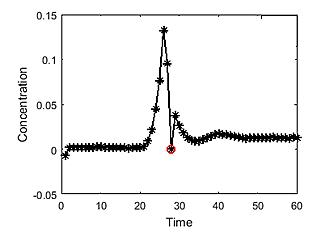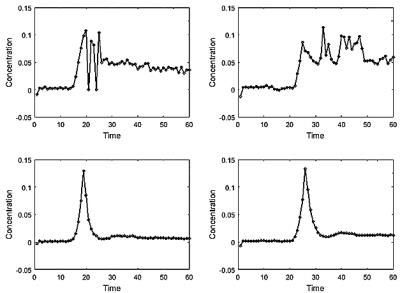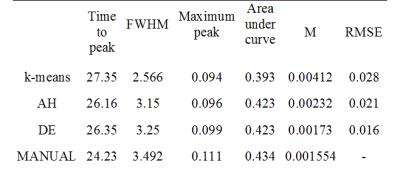Hossein Rahim Zadeh1, Anahita Fathi Kazerooni1,2, Mohammad Reza Deevband3, and Hamidreza Saligheh Rad1
1Quantitative MR Imaging and Spectroscopy Group, Research Center for Molecular and Cellular Imaging, Tehran University of Medical Sciences, Tehran, Iran, 2Department of Medical Physics and Biomedical Engineering, Tehran University of Medical Sciences, Tehran, Iran, 3Shahid Beheshti University of Medical Sciences, Tehran, Iran
Synopsis
Proper
arterial input function (AIF) selection is a critical step for accurate
quantification of dynamic susceptibility contrast enhanced (DSC) MRI in brain
tumor patients. In this study, we have employed differential evaluation (DE)
clustering method on processed perfusion images for accurate AIF selection. The
procedure consists of two main steps: preprocessing for eliminating
non-arterial curves including tissue, noisy and those contaminated with partial
volume effects; and AIF selection using DE clustering method. The performance
of this clustering method was compared to K-means and Hierarchical Clustering
techniques and the results show the superiority of the proposed approach for
accurate AIF selection.
Introduction
Arterial Input Function
(AIF) selection plays an important role in absolute quantification of perfusion
parameters using dynamic susceptibility contrast enhanced (DSC-) MRI 1. Manual AIF selection
is time-consuming and depends on the expertise of the radiologist. So, employing
automatic methods is desirable. The main disadvantage of previously-proposed
automatic AIF selection methods is their lack of information about the global
shape of the clusters which complicates separation of overlapping clusters, and
their implementation on normal subjects; therefore, their performance can be
compromised in cases of analysis for brain tumor patients 2. Hence,
in this study, we evaluated metaheuristic differential evolution (DE) algorithm to find a
global optimal solution for optimization of clusters during the search for the
proper AIF.Methods
In this study, DSC-MR images of 43 patients (20 low-grade glioma,
and 23 glioblastoma multiforme (GBM)) with brain tumors were downloaded from
the Cancer Imaging Archive Database 3. Automatic AIF selection depends
on the characteristics of concentration-time curve, such as the maximum peak
(MP), full width at half maximum (FWHM), area under curve (AUC),
time to peak (TTP). Arterial curve has higher maximum peak, area under curve
and lower time to peak, FWHM in comparison others. The steps for AIF selection
are as follow: (1) consecutive perfusion images in a
series were aligned to the first pre-contrast image; (2) to eliminate the curves of tumorous region that mimic
arterial curves, k-means clustering was used to classify the signal intensity
curves into five clusters. As the mean signal intensity of the baseline for the
tumorous region is higher than other brain regions, the cluster with the
highest mean baseline value was removed as a tumorous cluster; (3) area under the concentration curves was
calculated and 90% of the curves with lowest values were discarded; (4) Differential
evolution algorithm with 5 clusters was applied to the remaining curves AIF
cluster was selected by calculating the measure M=MP/ (TTP × FWHM). The
performance of this method in AIF selection according to the expert’s selection
was compared against K-means and Agglomerative Hierarchical (AH) clustering
methods.Results
Average
value of automatic and manual AIF shape parameters i.e. FWHM, time to peak,
maximum peak, area under curve and M -value (M=MP/ (TTP × FWHM)) were
calculated for 43 data and used for statistical analysis. Then, the differences
between automatic and manual AIF were computed by root-mean-square (RMS). Statistical
analysis using paired t-test was used (with significance level of P-value<0.05).
The mean
values of AIF shape parameters obtained by AH and DE clustering were closer to
manual selection and RMSE decreased remarkably in comparison with K-means
clustering. Among AH and DE clustering methods, DE showed lower RMSE error and mean
values of AIF shape parameters (Table1) in DE clustering showed better results.Discussion
Finding proper clustering method for AIF
selection has been challenging. So, in this study, we evaluated the capability
of differential evaluation clustering method for AIF selection. According to Table
1, the mean values and paired t-test analysis results, both AH and DE
clustering methods had better result in comparison K-means clustering. In RMSE
measurement, DE outperformed AH, meaning that the chosen AIF by DE clustering
method was closer to manual selection in comparison with AH method. In some
data, all three clustering methods, wrongly selected noisy and truncated curves
as AIF (Figs.1, 2).Conclusion
The proposed pre-processing and clustering
approach for AIF selection, showed good agreement with the AIFs selected by an
expert, implying that it is necessary to carefully undertake preprocessing steps
besides employing an accurate clustering method, to increase the accuracy and
precision of automatic AIF selection.Acknowledgements
No acknowledgement found.References
1. Shiroishi MS,
Castellazzi G, Boxerman JL, D'Amore F, Essig M, Nguyen TB, et al. Principles of
T2*-weighted dynamic susceptibility contrast MRI technique in brain
tumor imaging. Journal of Magnetic Resonance Imaging. 2015;41(2):296-313.
2. Das S, Abraham A, Konar A. Automatic
clustering using an improved differential evolution algorithm. IEEE
Transactions on systems, man, and cybernetics-Part A: Systems and Humans.
2008;38(1):218-37.
3. Clark K, Vendt B, Smith K, Freymann J,
Kirby J, Koppel P, et al. The Cancer Imaging Archive (TCIA): maintaining and
operating a public information repository. Journal of digital imaging.
2013;26(6):1045-57.


